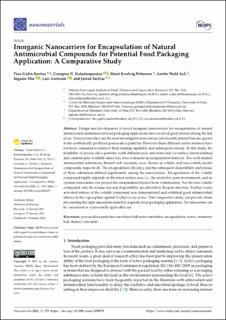| dc.description.abstract | Design and development of novel inorganic nanocarriers for encapsulation of natural antimicrobial substances for food packaging applications have received great interest during the last years. Natural nanoclays are the most investigated nanocarriers and recently interest has also grown in the synthetically produced porous silica particles. However, these different carrier matrices have not been compared in terms of their loading capability and subsequent release. In this study, the feasibility of porous silica particles (with different pore structures and/or surface functionalities) and commercially available nanoclays were evaluated as encapsulation matrices. Two well-studied antimicrobial substances, thymol and curcumin, were chosen as volatile and non-volatile model compounds, respectively. The encapsulation efficiency, and the subsequent dispersibility and release, of these substances differed significantly among the nanocarriers. Encapsulation of the volatile compound highly depends on the inner surface area, i.e., the protective pore environment, and an optimal nanocarrier can protect the encapsulated thymol from volatilization. For the non-volatile compound, only the release rate and dispersibility are affected by the pore structure. Further, water-activated release of the volatile compound was demonstrated and exhibited good antimicrobial efficacy in the vapor phase against Staphylococcus aureus. This comparative study can provide a base for selecting the right nanocarrier aimed at a specific food packaging application. No nanocarrier can be considered as a universally applicable one. | |
